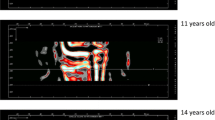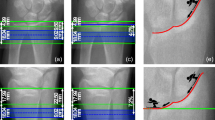Abstract
We previously showed that it is possible to cross-calibrate peripheral bone densitometers using the European Spine Phantom (ESP). We have now performed a multinational study of cross-calibrated radius bone density based on normal subjects of both sexes in eight European centers. Six centers were equipped with machines made by Scanco or Stratec for determining distal radial trabecular bone density by quantitative computed tomography (QCT) and two were equipped with Lunar SP2 single photon absorptiometry (SPA) equipment for measuring midshaft cortical bone density. Subjects recruited ranged from 20 to over 80 years of age. Over one hundred and fifteen men were studied by QCT and a different cohort of 104 men were studied with SPA; the equivalent figures for women were 235 and 123. Reference ranges were derived for bone density against age for each of the four groups, and their applicability is discussed in relation to between-center differences in the results obtained. There were insignificant differences (P>0.05 with Bonferroni correction) between centers in the values obtained by QCT in the different populations. However, there were considerably larger and highly statistically significant differences between midshaft cortical bone density values of about 10% of overall means between subjects from eastern Finland and central Belgium (P<0.001), with higher Finnish values. Women had considerably lower radial trabecular bone density values than men at all ages, a result that differentiates the radius from the spine. This sex difference widened after menopause. These results have important implications for understanding the contribution of bone density to the differential risk of Colles' fracture in the two sexes and suggest that further work is needed to establish young normal reference ranges for radial bone density in Europe.
Similar content being viewed by others
References
Gardsell P, Johnell O, Nilsson BE (1989) Predicting fractures in women by using forearm bone densitometry. Calcif Tissue Int 46:235–342
Hui SL, Slemenda CW, Johnston CC (1989) Baseline measurement of bone mass predicts fracture in white women. Ann Intern Med 111:355–361
Cummings SR, Black DM, Nevitt MC, Browner WS, Cauley JA, Ensrud K, Genant HK, Palermo L, Scott, J, Vogt TM (1993) Bone density at various sites for prediction of hip fractures. Lancet 341:72–75
Neer RM (1992) The utility of single photon absorptiometry and dual-energy X-ray absorptiometry [Commentary]. J Nucl Med 33:170–171
Geusens P, Dequeker J, Verstraeten A, Nijs J (1986) Age-, sex-, and menopause-related changes of vertebral and peripheral bone: population study using dual and single photon absorptiometry and radiogrammetry. J Nucl Med 27:1540–1549
Schneider P, Börner W (1991) Periphere quantitative Computertomograhie zur Knochenmineral-messung mit einem neuen spziellen QCT-Scanner. Fortschr Röntgens 154:292–299
Wapniarz M, Lehmann R, Randerath O, Baedeker S, John W, Klein K, Allolio B (1994) Precision of dual X-ray absorptiometry and peripheral computed tomography using mobile densitometry units. Calcif Tissue Int 54:219–223
Durand EP, Rüegsegger P (1992) High-contrast resolution of CT images for bone structure analysis. Med Phys 19:569–573
Pearson J, Ruegsegger P, Dequeker J, Henley M, Bright J, Reeve J, Kalender W, Felsenberg D, Laval-Jeantet A-M, Adams JE, Birkenhager JC, Fischer M, Guesens P, Hesch R-D, Hyldstrup L, Jaeger P, Jonson R, Kroger H, van Lingen A, Mitchell A, Reiners C, Schneider P (1994). European semianthropomorphic phantom for the cross-calibration of peripheral bone densitometers. Assessment of precision, accuracy and stability. Bone Miner 27:109–120
Rüegsegger P, Kalender W (1993) A phantom for standardization and quality control in peripheral bone measurements by pQCT and DXA. Phys Med Biol 38:1963–1970
Dequeker J, Pearson J, Reeve J, Henley M, Bright J, Felsenberg D, Kalender W, Laval-Jeantet A-M, Rüegsegger P, Adams J, Diaz Curiel M, Fischer M, Galan F, Geusens P, Hyldstrup L, Jaeger P, Kotzki P, Kröger, Lips P, Mitchell A, Louis O, Perez Cano R, Pols H, Reid DM, Ribot C, Schneider P, Lunt M (1995) Dual X-Ray absorptiometry: cross-calibration and normative reference ranges for the spine. Results of a European Community Concerted Action. Bone 17:247–254
Pearson J, Dequeker J, Reeve J, Felsenberg D, Henley M, Bright J, Lunt M, Adams JE, Diaz Curiel M, Galan, F, Guesens P, Jaeger P, Kroger H, Lips P, Mitchell A, Perez-Cano R, Pols H, Rapado A, Reid D, Ribot C, Schneider P, Laval-Jeantet A-M, Rüegsegger P, Kalender W (1994) Dual X-ray absorptiometry of the proximal femur: normal European values standardised with the European Spine Phantom. J Bone Miner Res 10:315–324
Jonson R (1993) Mass attenuation coefficients, quantities and units for use in bone mineral determinations. Osteoporosis Int. 3:103–106
Royston JP (1991) Constructing time-specific reference ranges. Stat Med 10:675–690
Butz S, Wuster C, Scheidt-Nave C, Götz M, Ziegler R (1994) Forearm BMD as measured by peripheral quantitative computed tomography (pQCT) in a German reference population. Osteoporosis Int 4:179–184
Kröger H, Heikkinen J, Laitinen K, Kotaniemi A (1992). Dual-energy x-ray absorptiometry in normal women: a cross-sectional study of 717 Finnish volunteers. Osteoporosis Int. 2:135–140
Kröger H, Laitinen K (1992) Bone mineral density measured by dual-energy x-ray absorptiometry in normal men. Eur J Clin Invest 22:454–460
Elffors I, Allender E, Kanis JA, Gullberg B, Johnell O, Dequeker J, Dilsen G, Gennari C, Lopez Vaz AA, Lyritis G, Mazzuoli GF, Miravet L, Passeri M, Perez Cano R, Rapado A, Ribot C (1994) The variable incidence of hip fracture in Southern Europe. Osteoporosis Int 4:253–263
O'Neill TW, Varlow J, Felsenberg D, Silman AJ, the EVOS Group (1994) Sex and geographic influences on the prevalence of vertebral deformity. J Bone Miner Res (suppl 1)9:S271
Geusens P, Dequeker J, Verstraeten A, Nijs J (1986) Age- sex-and menopause-related changes of vertebral and peripheral bone: population study using dual and single photon absorptiometry and radiogrammetry. J Nucl Med 27:1540–1549
Kelly PJ, Twomey L, Sambrook PN, Eisman JA (1990) Sex differences in peak adult bone mineral density. J Bone Miner Res 5:1169–1175
Krall EA, Dawson-Hughes B (1993) Heritable and life-style determinants of bone mineral density. J Bone Miner Res 8:1–9
Gilsanz V, Ines Boechat M, Gilsanz R, Luiza Loro M, Roe TF, Goodman WG (1994) Gender differences in vertebral size in adults: biomechanical implications. Radiology 190:678–682
Genant HK, Gluer C-C, Lotz JC (1994) Gender differences in bone density, skeletal geometry and fracture biomechanics. Radiology 190:636–640
O'Neill TW, Varlow J, Silman AJ, Reeve J, Reid DM, Todd C, Woolf AD (1994) Age and sex influences on fall characteristics. Ann Rheum Dis 53:773–775
Rüegsegger P (1994) The use of peripheral QCT in the evaluation of bone remodelling. Endocrinologist 4:167–176
WHO (1994) Assessment of fracture risk and its application to screening for postmenopausal osteoporosis. WHO Tech Rep Series 843, WHO Geneva
Mazess RB, Barden HS (1990). Interrelationships among bone densitometry sites in normal young women. Bone Miner 11: 347–356
Pearson J, Dequeker J, Henley M, Bright J, Reeve J, Kalender W, Laval-Jeantet A-M, Rüegsegger P, Felsenberg D, Adams JE, Birkenhager JC, Braillon P, Diaz Curiel M, Fischer M, Galan F, Guesens P, Hyldstrup L, Jaeger P, Jonson R, Kalef-Ezras J, Kotzki P, Kroger H, van Lingen A, Nilsson S, Osteaux M, Perez-Cano R, Reid D, Reiners C, Ribot C, Schneider P, Slosman DO, Wittenberg G (1994) European semianthropomorphic spine phantom for the cross-calibration of bone densitometers. Assessment of precision, stability and accuracy. Osteoporosis Int 5:174–184
Author information
Authors and Affiliations
Rights and permissions
About this article
Cite this article
Reeve, J., Kröger, H., Nijs, J. et al. Radial cortical and trabecular bone densities of men and women standardized with the European forearm phantom. Calcif Tissue Int 58, 135–143 (1996). https://doi.org/10.1007/BF02526878
Received:
Accepted:
Issue Date:
DOI: https://doi.org/10.1007/BF02526878




